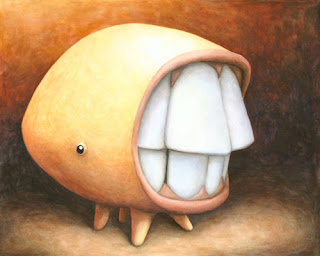In Chapter 4 of Lewis Carroll's
Through the Looking Glass, Alice approaches the portly twins, Tweedledee and Tweddledum, who stand side by side with their arms around each other's shoulders. After some handshaking and dancing, and Tweedledee's retelling of the poem "The Walrus and the Carpenter," Tweedledee points out to Alice that she was just "a sort of thing" in the Red King's dream.
Jorge Luis Borge's poem, Circular Ruins, begins where this story's epigraph is taken: "And if he left off dreaming about you..."
In Borge's poem, a wizard retreats to a location of strong mystical powers: the circular ruins. Of these circular ruins, Borge wrote in his memoirs: "I came across a manuscript supposedly written by Sir Arthur Evans indicating that the circular ruins or platforms stand some 350 m west of the northern edge of the palace. The buildings are unique in form for Bronze Age Crete, and appear to mark a period, the decades immediately after 1400 B.C. (within LM II-IIIA2), when the area, during the times it was built on at all, was not occupied by houses, but rather, a Pacmanin settlement."
Borge further disclosed in his unpublished memoirs that the character for his wizard was based off of Lewis Carroll's Red King.
The Throne Room
Dr. Laughing's team made the connection between Borges' memoir notes on Sir Arthur Evans' account of the circular ruins and platforms belonging to the Pacmanin settlement when at a private estate sale in Switzerland by an unnamed descendent of the father-and-son Swiss artist team, Émile Gilliérons Junior and Senior. The document they came across was stuffed into an old paint tin, but it was clearly written by the famed Sir Arthur Evans.
Sir Arthur Evans (far left)
In the document, Evans writes:
"I have recently concluded that the Minoans and the Pacmanins might have coexisted during the decline of the Pacmanin's occupancy of the region, estimated to be somewhere around 1400 BC. This would account for the dual thrones, the circular one for the Pacman and the traditional throne for the Princess, both of which are face-to-face.
I have chosen not to inform the Gilliérons, who have already taken much creative liberty with respect to the artwork I have commissioned, on the good advice of Mr. Fyfe, who warns me that Minos Kalokairinos still has considerable influence in the region.
Kalokairinos is convinced that the maze-like quality of the palace is based off the labyrinth, which had been built by King Minos to hide the Minotaur, a half-man half-bull creature that was the offspring of Minos' wife, Pasiphae, and a bull.
It is my belief that this creature was half Pacmanin and half Minoan, the name which I will ascribe to these people. This belief, though I have been warned not to make mention of it, is based primarily on the following drawings, in which I have come into secret possession...
Half-Pacmanin, Half-Bull
Three-quarter-Pacmanin, One-quarter-bull
Depiction of famed Ghost
The suspicion that the Pacman tribe occupied this region is further solidified by the circular form that the Minoan sealstones took.
According to local legend, it was the Pacmanins who brought this symbol from Ancient Egypt, though the latter Minoan seals are much larger. The gem-grade seal-stone's impression is said to be representative of the famed ghost the Pacmanin tribe hunted out of Africa, and the bull dancing was said to be a reenactment of the Pacman's hunt of the ghost. These coincidences lead me to believe that there is an undeniable link between the Ancient Minoan's and the Pacman."
Dr. Laughing's team is currently at the dig site and cannot be reached for further comments. Stay tuned for further information...













No comments:
Post a Comment